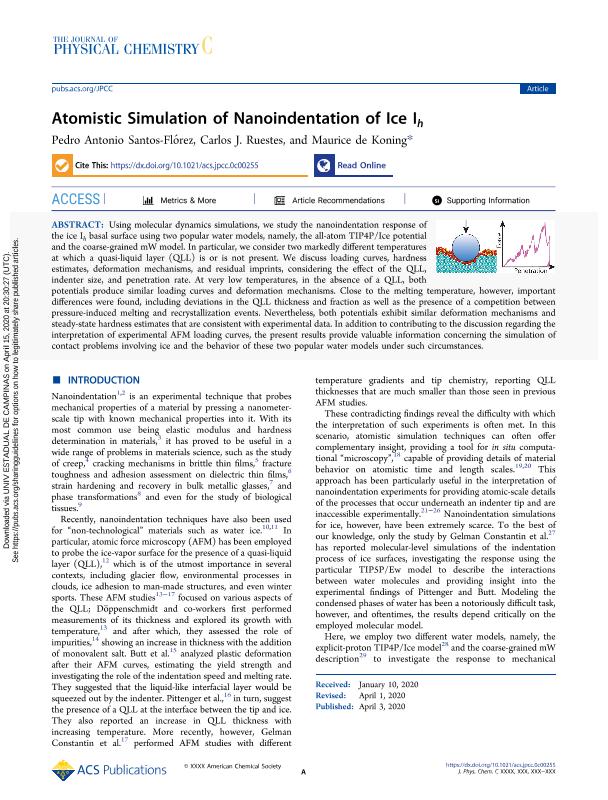Mostrar el registro sencillo del ítem
dc.contributor.author
Santos Flórez, Pedro Antonio
dc.contributor.author
Ruestes, Carlos Javier

dc.contributor.author
De Koning, Maurice
dc.date.available
2021-09-21T13:10:58Z
dc.date.issued
2020-04
dc.identifier.citation
Santos Flórez, Pedro Antonio; Ruestes, Carlos Javier; De Koning, Maurice; Atomistic Simulation of Nanoindentation of Ice Ih; American Chemical Society; Journal of Physical Chemistry C; 124; 17; 4-2020; 9329-9336
dc.identifier.issn
1932-7447
dc.identifier.uri
http://hdl.handle.net/11336/140981
dc.description.abstract
Using molecular dynamics simulations, we study the nanoindentation response of the ice Ih basal surface using two popular water models, namely, the all-atom TIP4P/Ice potential and the coarse-grained mW model. In particular, we consider two markedly different temperatures at which a quasi-liquid layer (QLL) is or is not present. We discuss loading curves, hardness estimates, deformation mechanisms, and residual imprints, considering the effect of the QLL, indenter size, and penetration rate. At very low temperatures, in the absence of a QLL, both potentials produce similar loading curves and deformation mechanisms. Close to the melting temperature, however, important differences were found, including deviations in the QLL thickness and fraction as well as the presence of a competition between pressure-induced melting and recrystallization events. Nevertheless, both potentials exhibit similar deformation mechanisms and steady-state hardness estimates that are consistent with experimental data. In addition to contributing to the discussion regarding the interpretation of experimental AFM loading curves, the present results provide valuable information concerning the simulation of contact problems involving ice and the behavior of these two popular water models under such circumstances.
dc.format
application/pdf
dc.language.iso
eng
dc.publisher
American Chemical Society

dc.rights
info:eu-repo/semantics/openAccess
dc.rights.uri
https://creativecommons.org/licenses/by-nc-sa/2.5/ar/
dc.subject
hardness
dc.subject
ice
dc.subject
quasi-liquid layer
dc.subject
deformation
dc.subject.classification
Físico-Química, Ciencia de los Polímeros, Electroquímica

dc.subject.classification
Ciencias Químicas

dc.subject.classification
CIENCIAS NATURALES Y EXACTAS

dc.title
Atomistic Simulation of Nanoindentation of Ice Ih
dc.type
info:eu-repo/semantics/article
dc.type
info:ar-repo/semantics/artículo
dc.type
info:eu-repo/semantics/publishedVersion
dc.date.updated
2021-08-25T19:29:17Z
dc.journal.volume
124
dc.journal.number
17
dc.journal.pagination
9329-9336
dc.journal.pais
Estados Unidos

dc.journal.ciudad
Washington
dc.description.fil
Fil: Santos Flórez, Pedro Antonio. Universidade Estadual de Campinas; Brasil
dc.description.fil
Fil: Ruestes, Carlos Javier. Consejo Nacional de Investigaciones Científicas y Técnicas. Centro Científico Tecnológico Conicet - Mendoza. Instituto Interdisciplinario de Ciencias Básicas. - Universidad Nacional de Cuyo. Instituto Interdisciplinario de Ciencias Básicas; Argentina
dc.description.fil
Fil: De Koning, Maurice. Universidade Estadual de Campinas; Brasil
dc.journal.title
Journal of Physical Chemistry C

dc.relation.alternativeid
info:eu-repo/semantics/altIdentifier/url/https://pubs.acs.org/doi/abs/10.1021/acs.jpcc.0c00255
dc.relation.alternativeid
info:eu-repo/semantics/altIdentifier/doi/http://dx.doi.org/10.1021/acs.jpcc.0c00255
Archivos asociados
